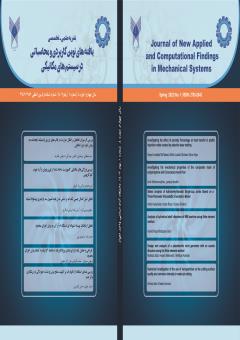بررسی عددی استفاده از نانوذرات بر کیفیت سطح برش و شدت خوردگی در برشکاری واتر جت
محورهای موضوعی : یافته های نوین کاربردی و محاسباتی در سیستم های مکانیکی
1 -
2 - گروه مکانیک دانشگاه آزاد اسلامی واحد ایذه
کلید واژه: واتر جت, حل عددی, شدت آشفتگی, خوردگی,
چکیده مقاله :
همگام با پيشرفت صنعت و تكنولوژي، نياز به دستگاه ها و تجهيزات متنوع و تك منظوره افزايش مي يابد. استفاده از نانوذرات فلزی از قبیل ذرات فولادی برای برشکاری در واتر جت از اهمیت ویژه ای برخوردار بوده و سرعت برشکاری را افزایش خواهد داد. در این پژوهش نتایج مربوط به پارامترهای مختلف جریان از قبیل توزیع فشار استاتیک و توزیع سرعت، در واتر جت و اطراف آن با تغییر پارامترهای مختلف مورد بررسی و تحلیل قرار گرفته است. همچنین با بحث درباره ناحیه مناسب برای برشکاری، هر کدام از پارامترهای جریان واتر جت بر این ناحیه تحلیل شده است. هرچه آشفتگی جریان کمتر باشد کیفیت برشکاری بهتر و خروجی سرعت نیز یکنواختی بهتری دارد و میزان افت سرعت کمتر خواهد بود. در نهایت مشخص گردید انرژی جنبشی و شدت آشفتگی با افزایش قطر ذرات از 5-10×10 تا 4-10×10 متر در دبی جریان 2/0 کیلوگرم بر ثانیه به ترتیب 73/8 و 60/4 درصد کاهش و شدت خوردگی و فشار عمودی ناشی از ذرات به ترتیب 20/737 و 45/334 درصد افزایش خواهند شد.
Along with the progress of industry and technology, the need for diverse and single-purpose devices and equipments increases. In addition to this diversity, the different tastes of users and the trend towards the development of the industry have caused that other old production systems such as ordinary lathes are not able to respond to the continuous changes in market demands. In this research, the results related to different flow parameters, such as static pressure distribution and velocity distribution, in the water jet and its surroundings have been investigated and analyzed by changing different parameters. It has been tried to discuss the suitable area for cutting each of the water jet flow parameters on this area. The lower the turbulence of the flow, the better the cutting quality and the more uniform the speed output, and the lower the speed drop. Kinetic energy and turbulence intensity with the increase of particle diameter from 10x10-5 to 10x10-4 m at flow rate of 0.2kg/s decrease by 8.73% and 4.60% respectively and the intensity of corrosion and vertical pressure caused by particles They will increase by 737.20 and 334.45 percent, respectively.
[1] Kovacevic, R.; Hashish, M.; Mohan, R.; Ramulu, M.; Kim, T.J.; Geskin, E.S. (1997) State of the art of research and development in abrasive waterjet machining. Transactions of ASME. Journal of Manufacturing Science and Engineering, 119: 765-785.
[2] Selvan, M.C.; Raju, N.M.; Sachidananda, H.K. (2012) Effects of process parameters on surface roughness in abrasive waterjet cutting of aluminum. Frontiers of Mechanical Engineering 7(4): 439–444.
[3]Akkurt, A.; Mustafa, K. K.; Ulvi, S.C.; Fevzi, E. (2004) Effect of feed rate on surface roughness in abrasive water jet cutting applications. Journal of Materials Processing Technology, 147: 389–396.
[4] Metin, K.; Erdogan, K.; Omer, E. (2011) Prediction of surface roughness in abrasive waterjet machining of particle reinforced MMCs using genetic expression programming. The International Journal of Advanced Manufacturing Technology, 55: 955–968.
[5] Caydas, U.; Hascalik, A. (2008) A study on surface roughness in abrasive waterjet machining process using artificial neural networks and regression analysis method. Journal of Materials Processing Technology, 202: 574–582.
[6] Jurisevic, B.; Brissaud, D.; Junkar, M. (2004) Monitoring of abrasive water jet (AWJ) cutting using sound detection. The International Journal of Advanced Manufacturing Technology, 24: 733–737.
[7] Kechagias, J.; Petropoulos, G.; Vaxevanidis, N. (2012) Application of Taguchi design for quality characterization of abrasive water jet machining of TRIP sheet steels. The International Journal of Advanced Manufacturing Technology, 62: 635–643.
[8] Parikh, P.J.; Lam, S.S. (2009) Parameter estimation for abrasive waterjet machining process using neural networks. The International Journal of Advanced Manufacturing Technology, 40: 497–502.
[9] Chen, F.L.; Siores, E. (2003) The effect of cutting jet variation on surface striation formation in abrasive water jet cutting. Journal of Materials Processing Technology, 135: 1-5.
[10] Nilesh Kumar Sharma , Satish Kumar Dewangan, Pankaj Kumar Gupta, CFD analysis of slurry jet behavior after striking the target surface and effect of solid particle concentration on jet flow, 2021.05.475

